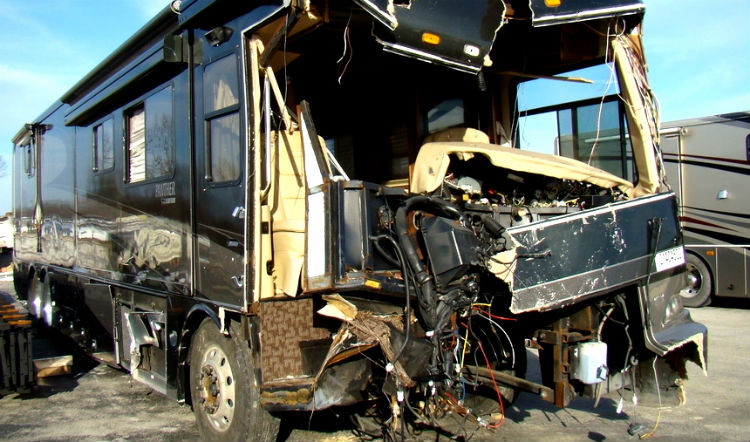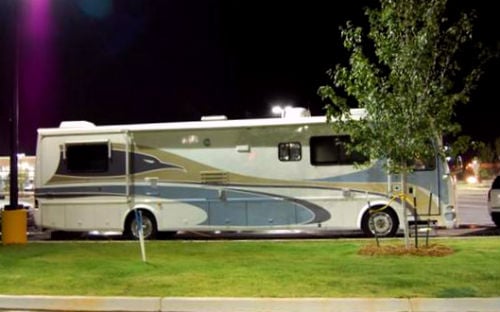Drunk driving is bad for everyone. But when it comes to drunk drivers, a 2016 study by the American Automobile Association’s (AAA) Foundation for Traffic Safety reports these rolling time bombs are actually safer behind the wheel than drowsy RV drivers.

Falling asleep at the wheel can have devastating consequences. Photo by slemnah iRV2com member
Even missing just one hour of sleep can make drivers as risky as an inebriated drunk behind the wheel. The study by the AAA Foundation for Traffic Safety states that “Drivers who miss between one to two hours of the recommended seven hours of sleep in a 24-hour period nearly double their risk for a crash.”
Even more surprising was the news by Dr. David Yang, executive director for the foundation, who says: “Our new research shows that a driver who has slept for less than five hours has a crash risk comparable to someone driving drunk.”
Just because RVers take their bedroom on the road doesn’t mean they’re less at risk. Effective snoozing doesn’t always come easy at noisy rest areas, brightly lit or busy Walmart camping parking lots and RV parks perched next to interstates or other bustling areas.

Effective snoozing doesn’t always come easy at noisy or brightly-lit rest areas. Photo by RV Wizard iRV2.com member
When a drowsy RV driver gets behind the wheel and commandeers a motorhome or trailer, that person is potentially even more of a risk on the highway than sleep impaired drivers at the wheel of passenger cars. An uncontrolled RV can do far more damage than a sedan. How to handle and drive your RV like a pro takes some time, but when you’re drowsy those skills become severely hindered.
Better RV driving starts with a plan
RV drivers who wait until they’re sleepy to pull over are playing Russian roulette. Navigating a large RV is more intense than driving a passenger car. Even when you’re not sleepy you need to concentrate harder to create safe conditions. On any RV road trip, your focus should be on preparing to rest before you get that tired. For instance, drowsy RV drivers should consider:
- Drive shorter distances than when you’re driving a passenger car.
- Trade driving duties with capable passengers who can drive your RV.
- Only stay behind the wheel two hours at a time. Stop and take a 20 minute nap. Sleep experts say even 20 minutes will help refresh a drowsy RV driver.
- Take breaks. Make a sandwich, brew a cup of coffee, and walk around. The fresh air will wake you up and prepare you for more miles.
Most people don’t realize when they’re about to nod-off behind the wheel. But the human body gives lots of clues before it tries to snooze.
Here’s how you know you’re too drowsy to drive
Your body is much better at giving you sleep signals than you think. Common signs that you’re about to join the unfortunate drowsy RV drivers on the road include:
- Yawning repeatedly
- Rubbing your eyes
- Hitting a rumble strip
- Not remembering the last few miles
- Missing exits and traffic signs
When these signals hit, many people don’t always know the best ways to stay awake while driving. Dumb things people do to try to stay awake can actually make them sleepier, like eating sugary snacks or drinking a soda.
“Sugar is not helpful and can make you sleepier after 30-90 minutes than if you had no sugar,” writes the National Sleep Foundation. Drivers should always opt for healthier snacks like sunflower seeds instead. Even drinking coffee isn’t an instant pick-me-up because it takes about 30 minutes for the caffeine to kick in.
Nodding off behind the wheel is just like trying to fall asleep on a pillow – it happens before you realize it. Don’t wait until you think you’re sleepy or it could be too late to avoid a horrible RV accident that puts an end to all your road trips.

Before we retired it was all about “getting there”. With only a weekend to camp, we drove hard and long to get to our destination.
These days we drive 4 hours a day. We drive 2 hours, take a 30 – 45 minute break, drive another 2 hours, then park for the night.
And, most Walmarts where we’ve overnighted have been relatively quiet and safe.
We do the same thing…. begin travels around 10-11…… and stop by 4 at the latest. So much easier to do hookups in the light of day. Then ..it is 5 o’clock somewhere in some time zone!
The rule we try to adhere to is 4 hours driving by 4pm… sometimes it is before 4…just because!
I am up early (on the road at 8:30) to arrive at the RV park early. I like to arrive by no later than 4:00 pm at the latest (typically I get there before three). I like to stop along the way at view points and other sites on the way. Early arrival allows for set up, having a beverage or time at the pool or hot tub, and dinner at a descent time..